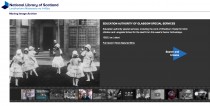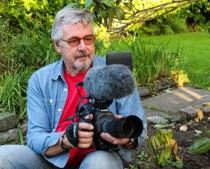Some 20 years ago an urban fairy tale did the rounds in Manchester. It is midnight on Christmas Eve at the Cornerhouse cinema as a tired projectionist looks down at the seats laid out below him. Capra’s “It’s a wonderful life” whirs through the projector gate and bathes the half dozen strangers sitting apart in the small auditorium in a flickering half-light. He sighs and curses himself for not checking if the night bus was running.
After Capra’s transformational journey has unfolded, the projectionist sets the alarm and locks up the cinema.
Whilst savouring the shrouded silence afforded by the freshly fallen snow he notices several pairs of footprints arcing out from the foyer in separate directions. Fresh from George Bailey’s realisation that he has lived a wonderful life, the cinema-goers had buttoned up their jackets against the Oxford Street chill and left as they arrived. Alone.
It’s a very Mancunian outcome to that tale don’t you think? Morrisey could have had a few b-sides from that one I reckon.
Whilst the technology in our living room and within our computers continue to shape the way we engage with narrative moving image in our homes, we are still drawn to the warming familiar glow of the cinema screen. We consider going to the cinema a communal experience. Although we may be absorbed within the narrative, we become aware of our fellow audience members through our laughter, jumping from our seats in unison, or from shared irritation at the chatty couple in row G.
There are other moments in cinema – not the jumps, not the laughs. Nor the epic establishing shots, or the final twist or unveiling – but moments in which an idea, an emotion, an event will be rendered so perfectly that it will extend and blossom outwith of its parent film. With no audible clues – no gasps, giggles or snivels – we ride out these moments within ourselves, unaware of their effect upon those around us. The opportunity to mull over these nugget like moments can often be lost in our discussion of the broader film on the journey home, particularly if the film disapointed.
So, at the end of this short, rambling post (I’m sorry but I find it far easier to express myself through film or animation) I have posted just a couple of movie moments that continue to transfix and inspire me in my own practice. I do so in the sincere hope that you may wish to share some of your own favourite moments by posting in the comments thread.
For better or worse we are exposed to moving image from an early age and unconsciously we begin to learn some of the rules that govern its creation and presentation.
I have sometimes been fortunate enough to be asked to teach practical and critical moving image techniques to children. To help the young people into a creative frame of mind I will often show them the opening sequences of a number of films. As I often use films that are several decades old the students normal reaction is to moan and gripe that they are going to have to sit through 10 minutes without a hint of CGI. Sometimes I’ll offend the class even further by introducing a foreign language with the subtitles turned off. My mainstays are “Bad Day at Black Rock”, “To Kill a Mockingbird” or “Night of the Hunter”, and for a foreign film I will normally use “The Devil’s Backbone” a great example of the classic ghost story beautifully executed.
Using “Bad Day at Black Rock” as an example:
A train cuts through a western landscape to an overblown soundtrack.
The title appears in enormous letters across the cinemascope screen.
Me: ”What’s going to happen in this film?”
Pupils: “Well how do we know? Nothing has happened yet?”
Me: “Listen to the music.”
Pupils: “Something bad is going to happen.”
“The train is out of control.”
“The train is bringing something or someone to Black Rock.”
Me: ”Who do you think is on the train?”
Pupils: “A murderer.”
“A bounty hunter.”
“A prisoner on the run.”
The train pulls into a dying desert town with a smattering of residents amongst the few houses. The train hasn’t stopped here for many years. A one armed man (an aged Spencer Tracy) disembarks and is immediately greeted with great suspicion from the locals he encounters.
Me: “Who is the man and why are the towns people so distrustful of him?”
Pupils: “He has a score to settle.”
“He’s the new Sheriff.”
“No. He’s just an old, one armed guy – what harm can he do to them?”
“He or the townspeople are hiding a secret.”
… and so on, until I turn it off to ask some more questions about the direction that the film might take and the choices the filmmaker made in establishing the mood.
I am not hailing “Bad Day at Black Rock” as the greatest film, but it and many other films are great ways of encouraging young people to develop an understanding of moving image literacy.
Whichever film I use the kids usually implore me to let them continue watching – not to escape having to do any work (motivating young people to take an active part in a class about film and filmmaking is thankfully not a concern), but from a genuine desire to see what happens next, to look around the corner, to walk to the next hill, to see what lies beyond.
On their own, channel flicking at home, chances are they would have continued past an old or foreign film. Being able to share the experience with their classmates and encouraged to analyze the filmmakers’ choices they become invested in the story. Connected to the one armed man, to Scout and Jem Finch, to the brother and sister fleeing Robert Mitchum, even to Santi the wronged boy haunting the orphanage in Del Toro’s tale.
To my great satisfaction and without fail, 5 or 6 of the kids (or their parents) will ask for details of the DVD so they can watch the film at home and share it amongst their classmates. The communal experience of watching and discussing a short piece of cinema brings a class of disparate kids together.
And so, in the spirit of sharing, here’s just a couple of scenes that have captivated me over the years.
Have a peek at them and perhaps even seek out the originals, but be sure to post examples of cinematic moments that have connected with you in some way. Be honest, this isn’t like spreading out all those novels by french authors around your bedroom to try and impress someone, but it is perhaps best to share clips from lesser known works.
Keep sharing and look out for one another’s footprints in the snow when you exit the theatre.
In the Soup – 1992 – Alexandre Rockwell
the Break-in scene
Self conscious screenwriter Aldolfo (Steve Buscemi) has written an unfilmable 500-page screenplay and is looking for a producer. In steps Aldolfo’s “guardian angel”, Joe (Seymour Cassel at his best) a fast-talking shyster who promises to produce the film but has his own unique ideas regarding film financing. In this scene Aldolfo finds himself unwittingly taking part in a break-in and the stage is set for an unexpected and heartbreaking confrontation with the elderly home owner.
The scene is established from about 2mins 20secs
Dreams – 1990 – Akira Kurasawa
the Fox Procession scene
A small boy witnesses the slow wedding procession of a fox, a sacred ceremony not meant for the eyes of man.
Night of the Hunter – 1955 – Charles Laughton
the River Boat scene.
Okay, forgive me for this far more well known clip, I’m sure many of you know and love this classic scene.
Reverend Harry Powell (Robert Mitchum), a serial killer and self-appointed preacher, relentlessly pursues the children of his dead cell mate in order to uncover a cache of stolen money.
Links:
My website.
http://www.fortsunlight.co.uk
The Art of the Title Sequence
http://www.artofthetitle.com/
Scottish Screen’s moving image education website – a great resource for parents and teachers.
http://www.movingimageeducation.org/














Comments